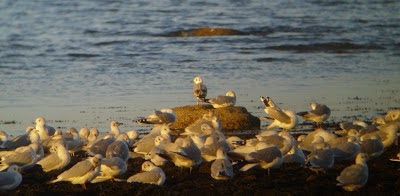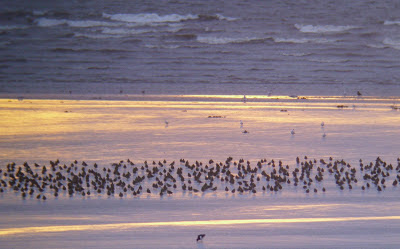View above from Ferny Ness on Thursday evening, a nice scene except for the fact that there were now 12 dead Guillemots in a 200m stretch, and more beyond! Next shot is the auk hunt team, operating for 10p per bird:

More seriously, there have been some recent discussions of the reasons for the current auk wreck in the Forth, with many displaced seabirds heading inland too, including Guillemots both far inland and in exceptional numbers on some inland waters. One possible explanation is that this is a result of a shortage of food in a wider area, these being food stressed birds which have come to the Forth due to absence of normal feeding in their usual areas. However I suspect that this is not the whole story. Perhaps on the contrary it was relatively good feeding earlier this year that has drawn greater numbers of seabirds into the Forth - witness the earlier fish shoals which attracted hordes of feeding gulls and Gannets, and the exceptional influx of terns from earlier in the summer. Certainly terns were taking sandeels earlier but gulls, terns and auks were seen all seen taking sprats at shoals in August (was it a coincidence the pilot whales appeared around the same time?)
It was in August that the auk numbers ramped up markedly with estimates of thousands on the sea off Musselburgh and in Gosford Bay; one can only presume their arrival at that stage was nothing to do with hardship but more about the shoals of sprats, and/or, other fish (cf. discussion of seasonal trend in diet in earlier blog post). In many thousands some are always destined to perish in the challenge of feeding themselves, especially young birds, so some mortality would have been expected (we have this every year with young Gannets). More recently they have presumably been hampered by strong winds in stormy weather last week; until the winds increased I suspect there may not have been any greater numbers of fatalities than occur normally, pro rata, but now it seems that we are definitely experiencing a significant wreck (cf. also report of 91 dead Guillemots in 2.5 km at Blackness on 27 September).
Referencing the Bird Study paper [1] on the 1983 wreck we find these observations:
The total of 34,000 birds killed in the latest wreck exceeds the highest kill previously recorded in a wreck in Britain.
Most of the corpses examined during the wreck were emaciated (Hope Jones et al 1984), indicating that the birds had been in poor physical condition before their deaths. There was no evidence of any infectious disease.
Most wrecks of seabirds are associated with severe weather conditions such as storms and gales, and these are likely to contribute to the deaths of the birds. Storm conditions can influence mortality by (a) displacing birds perhaps to areas with less food, (b) by making food more difficult to obtain or (c) through increased heat loss and battering. Birkhead (1976) suggested that Guillemots may have difficulty in finding and capturing food when strong winds cause rough seas. The severe westerly gales in January 1983 may have displaced auks from northern waters into more sheltered areas in the North Sea. In January, particularly high numbers of auks were seen close inshore in Shetland.
The arrival of dead and dying birds along the east coast closely followed the 5 February change in wind direction from westerly to easterly. A routine Beached Bird Survey at the end of January had not revealed any unusually high or low densities of auks on either the east or west coast, but on the Continent high numbers of corpses had been reported from at least mid-January and in some areas from December. It would appear that the birds were dying some time before British beaches received unusual numbers of corpses.
Despite the storm around 25 September (which brought Leach's Petrels to this same spot) it seems odd that it could have had such a drastic impact on these auks, which much be pretty hardy creatures wintering offshore in much worse weather. But perhaps timing is the key, if those perishing are mainly young inexperienced birds then perhaps they were not yet adequately prepared for severe weather?
Thus it would also be worth examining these corpses to age them, comments from Mike Harris per forthbirding post: "Birds are aged using the greater (longest) underwing coverts. In 1st winter birds these have obvious clearly defined white tips. Older birds have grey coverts. Birds with silvery white tips without a clear border between grey and whitish should not be classified." See also ageing manual on www.oiledwildlife.eu
Some examples below from the birds at Ferny Ness:
Seems those above are indeed youngsters (as were probably 4 out of 6 birds examined carefully, a very small sample though) - the three lower images above are all from one individual very freshly dead, now sent for post mortem.
Three photos below are apparently an adult, in full primary moult when it died (per BWP, adult post-breeding moult "Starts with head and body in late July, completed November. Primaries late July to September; shed within 1–3 days. Secondaries late August to late September. Flightless for c. 45–50 days, until primaries 70–80% grown".
Gulls may be playing some role in dispatching many of these birds - such as the young GBB killing one on adjacent Gosford Sands on Sunday; someone else mentioned to me 8 auks floating in sea off Portobello on 27 September, and witnessing "at least 3 being killed by gulls [twice by Great Black Backed and once a Herring Gull] by drowning. Each time they grabbed them whilst a "feeding frenzy" was going on and then drowned them, on each occasion they gave up trying to eat them as it seemed to difficult to do this in the water and just left them floating."
Another unexplained feature is all these dead birds seem to be Guillemots, whilst I had estimated 60% of the 850 auks visible in Gosford Bay on 24 August were Razorbills - so why the apparent difference in mortality now - where have all the Razorbills gone?
To end of a positive note, there was a further paper on the 1983 wreck, this being an assessment of impact on subsequent breeding, which determined this to be relatively minor [2]. So hopefully they will bounce back again this time too.
[1] Underwood, L.A. & Stowe, T.J. (1984) "Massive wreck of seabirds in eastern Britain", Bird Study 31:2, 79-88
[2] Harris, M.P. & Wanless, S. (1984) "The effect of the wreck of seabirds in February 1983 on auk populations on the Isle of May (Fife)", Bird Study 31:2, 103-110


















